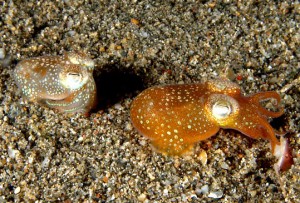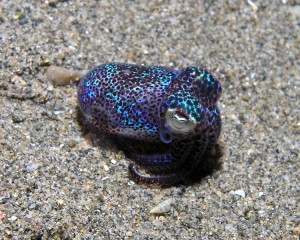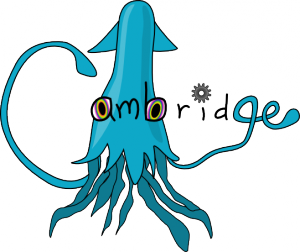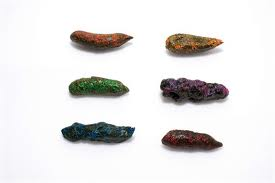MONDAY, 19 SEPTEMBER 2011
Squids and octopi (cephalopods) are renowned for their stunning ability to change their skin colour, as a means of camouflage and communication. Although this has attracted much scientific interest in the past, however the precise mechanism underlying this colour-changing ability is still poorly understood. During summer 2011 a team of undergraduates from the University of Cambridge have worked to recreate this ability in harmless strains of E. coli bacteria, a simple form of life that is commonly grown and studied in labs.Certain squid species, including the Hawaiian bobtail (Euprymna scolopes) and members of the Loligo genus (e.g. european common squid, patagonian squid and siboga squid), are known to generate iridescence by utilising interference phenomena in the outermost layer of their skin. Within this layer, thin sheets of the protein reflectin, which has a high refractive index, are separated by layers of other materials of lower refractive index. When light moves between layers with different refractive indexes it can be bent and scattered resulting in iridescence. This structure is known to physical scientists as a ‘Bragg stack’, and results in the squid appearing to exhibit different colours. The precise colour is principally controlled by varying the separation between reflectin sheets. It is believed that the squid can chemically control the sheet spacing to create dynamic iridescence (deliberate changes in colouration), though it is still unknown how exactly how this is achieved.
As part of the 2011 international Genetically Engineered Machine (iGEM) competition, the Cambridge team, dubbed Bactiridescence will attempt to create E. coli bacteria with the ability to synthesise and carefully organise layers of reflectin and generate their own iridescence.
Teams of undergraduates from top universities compete in iGEM to create novel genetically-modified organism over the course of a summer vacation, often with a focus on solving a current local or global problem. Bactiridescence hope to build the groundwork for a new generation of simple, accurate and affordable biosensors that use dynamic iridescence as an easily understandable output. Biosensors are particularly useful fro detecting chemicals, from heavy-metal ions in contaminated water to nitrates in the soil, and would be particularly suitable in Third World countries where more expensive synthetic sensors are unaffordable.
Cambridge has been a highly successful contestant at previous iGEM competitions. The team E.Chromi was awarded the international Grand Prize in 2009 for creating a series of strongly pigmented bacteria in a full rainbow of colours. This was also intended as a biosensor output and the team were able to tune their colour changes with a high degree of accuracy for a variety of applications. Working with designers from the Royal College of Arts, London, they further developed the possible uses of this technology to include clinical disease detection. A simple medical test would involve the ingestion of disease-sensing E.chromi bacteria and the resultant colour of the subject’s faeces giving a disease diagnosis. The project is still evoking a great deal of interest, and has been nominated for the Design of the Year Awards 2011.
In 2010, Cambridge’s E. Glowli was one of the most popular projects among their fellow contestants, winning the ‘iGEMer’s prize’, and was also highly regarded by the judges, who selected them as global finalists. They produced bioluminescent bacteria that could glow brightly in the dark without requiring the addition of chemicals, inspiring the concept of bioluminescent trees that naturally glow at night. By diverting just 0.02% of the energy gained from photosynthesis, this could theoretically remove the need for electric streetlamps, which was highly publicized by the press including New Scientist and the Daily Mail. Although this is highly conceptual and far from feasible at the moment, they received interest from a Ukrainian artist who wished to light FIFA’s Euro 2012 contest with the technology. This year an iGEM team from the University of East Anglia has extended this work to making bioluminescent algae and moss, a concept that will be familiar to fans of the 2009 film Avatar.
The major founding principles of the iGEM competition were to promote and encourage identification and isolation of useful genetic sequences throughout the biological world and to refine these into an open-source registry of ‘BioBricks.’ ‘BioBricks’ are intended to be a straightforward means of constructing more complex genetic systems with each brick expected to be universally compatible with all others. By building many bricks into an organism (Usually E. coli at the moment) they can work together and give rise to new processes with near infinite possible uses in terms of human industry and manufacturing. The ‘BioBrick’ system makes it much easier for future researchers to create their own designs, simply by joining standard bricks together, in a manner analogous to engineering electric circuits.
The iGEM founders also place a strong emphasis on the importance of good ethics in biology. The potential to misuse genetic modification is clear and as part of every entry teams must demonstrate how they have worked to ensure that their designs are responsible and ethical and must show how they have promoted stringent biosafety controls in the wider community.
You can follow the progress of team Bactiridescence their wiki, http://2011.igem.org/Team:Cambridge.
Written by Bactiridescence team member Katy Wei






